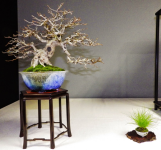JackHammer
Chumono
I am trying to understand principles of bonsai design particularly around tirtiary branches. The heuristic for secondary/main branches would be positioned on the outside of a bend (1-2-3 tree). However, I have no idea about how to think about positioning smaller branches, particularly as they approach the apex.
Below is an example that might illustrate my confusion. There is a general mess of branches that are not well defined in terms of structure, but this is still a clearly a refined tree. I don't know what patterns to look for. Any ideas?

Below is an example that might illustrate my confusion. There is a general mess of branches that are not well defined in terms of structure, but this is still a clearly a refined tree. I don't know what patterns to look for. Any ideas?

